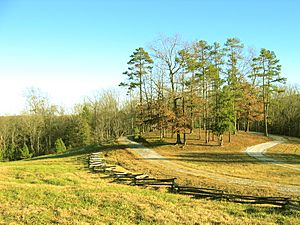Battle of Blackstock's Farm facts for kids
Quick facts for kids Battle of Blackstock's Farm (also called Blackstock's Plantation, Blackstock's Hill, and Blackstocks) |
|||||||
|---|---|---|---|---|---|---|---|
| Part of the American Revolutionary War | |||||||
 Blackstock Battle Memorial |
|||||||
|
|||||||
| Belligerents | |||||||
| Commanders and leaders | |||||||
| Strength | |||||||
| 270 regulars and militia | 1,000 militia | ||||||
| Casualties and losses | |||||||
| 51-167 killed and wounded | 3 killed 4 wounded 50 captured |
||||||
|
Battle of Blackstock's Historic Site
|
|
| Location | West of Union off South Carolina Highway 49, near Union, South Carolina |
|---|---|
| Area | 540 acres (220 ha) |
| Built | 1780 |
| NRHP reference No. | 74001885 |
| Added to NRHP | December 16, 1974 |
The Battle of Blackstock's Farm was an important fight during the American Revolutionary War. It happened in what is now Union County, South Carolina, close to Cross Anchor. The battle took place on November 20, 1780. It was a victory for the American Patriots.
Why the Battle Happened
After the Battle of Kings Mountain, American Patriots were gaining control. This was in the "Backcountry" areas of North and South Carolina. British General Charles Cornwallis was worried.
He ordered his skilled officer, Banastre Tarleton, to stop the Patriots. Tarleton was told to focus on Thomas Sumter. Sumter was a Patriot general leading a group of volunteers. He had gathered about a thousand men.
Getting Ready for Battle
On November 18, Tarleton's soldiers were resting by the Broad River. Some of Sumter's men fired at them from across the river. Tarleton was not happy about this.
He moved his men across the river that night. He then chased Sumter's forces very closely. Luckily for Sumter, a British soldier left Tarleton's group. This soldier told Sumter about Tarleton's plans.
Sumter had many men, but Tarleton had more trained soldiers. Tarleton had never lost a battle before. Sumter and his officers decided to find a strong place to fight. They wanted Tarleton to attack them there.
Colonel Thomas Brandon knew the area well. He suggested William Blackstock's farm. This farm was on hills near the Tyger River. The land was clear, which was good for fighting. The farm buildings were made of strong logs. They had small gaps that were perfect for shooting from cover.
The Battle Begins
Sumter placed his riflemen inside the farm buildings. Other units were hidden behind fences. Some were also hidden in the nearby woods. Tarleton arrived late in the afternoon. He decided to attack head-on. He did not wait for all his soldiers or cannons to arrive.
At first, Tarleton's attack seemed to work. The Patriot militia fired too early. Before they could reload, British soldiers charged them with bayonets. But these British soldiers got too close to the farm buildings.
Sumter's men inside the buildings fired at them. They aimed for the officers. Many British soldiers were killed or hurt. Meanwhile, other Patriots moved around the side. They attacked Tarleton's horse soldiers.
Tarleton realized he was losing. He ordered his horse soldiers to charge uphill. They had to charge against riflemen who were hidden. Many of Tarleton's horse soldiers were shot off their horses. The path became blocked with fallen men and horses.
The British soldiers still managed to retreat in an orderly way. Sumter moved forward to watch them leave. Some British soldiers fired at him and his officers. Sumter was badly wounded. He had to give command to Colonel John Twiggs.
Tarleton pulled back two miles. He planned to attack again the next morning. But Twiggs left campfires burning. Then he moved his men away quietly in the night. The next morning, Tarleton's troops buried the dead. Many more British soldiers had died than Americans.
Tarleton said that 51 of his men were killed or wounded. American reports said the British had 92 killed and 75-100 wounded. The Americans had only 3 killed, 4 wounded, and 50 captured.
What Happened After
Tarleton told his commander, Cornwallis, that he had won. He lied and said he had scattered the Americans. He also made a big deal about Sumter being wounded.
But the truth was, Tarleton had been beaten for the first time. His trained British soldiers had lost to American militia. This was a big deal. Even Sumter's injury turned out to be good for the Patriots. It allowed George Washington to put Nathanael Greene in charge of the Southern army. Greene was a very smart military leader.
The Battle of Blackstock's Historic Site was added to the National Register of Historic Places in 1974. This means it is a special place in American history.

